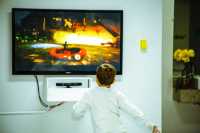
28 Aug TV and Furniture Tip-Overs Injure Children Every Day
MedicalResearch.com Interview with:

Dr. Gary Smith
Gary A. Smith, MD, DrPH
Director, Center for Injury Research and Policy
Nationwide Children’s Hospital
Columbus, OH
MedicalResearch.com: What is the background for this study?
Response: Furniture and TV tip-overs are an important source of injury, especially for children younger than 6 years old. Our study found that an estimated 560,200 children younger than 18 years old were treated in U.S. emergency departments for furniture or TV tip-over injuries from 1990 through 2019. In 2019, there were 11,521 injured children, which is an average of one child every 46 minutes.
MedicalResearch.com: What are the main findings?
Response: The study found that children younger than 6 years of age accounted for 70% of furniture and TV tip-over injuries, with a peak at 2 years old. Almost half (47%) of all injuries were to the head or neck. Patients younger than 6 years old were almost twice as likely to sustain a concussion or closed head injury than older patients. Approximately 3% of children were admitted to the hospital for additional treatment of their injuries, the majority of whom (82%) were younger than 6 years of age.
 TV tip-overs accounted for 41% of all tip-over injuries during the 30-year study period but the number of these injuries has decreased substantially since 2010. Approximately 10% of TV-associated injuries also involved simultaneous tip-over of furniture. Patients younger than 6 years old represented 75% of children injured by TV tip-overs.
TV tip-overs accounted for 41% of all tip-over injuries during the 30-year study period but the number of these injuries has decreased substantially since 2010. Approximately 10% of TV-associated injuries also involved simultaneous tip-over of furniture. Patients younger than 6 years old represented 75% of children injured by TV tip-overs.
Injuries associated with tip-overs of clothing storage units (CSUs), such as dressers and wardrobes, represent an important subset of about 17% of all tip-over injuries. Current voluntary safety standards to prevent tip-overs of CSUs are inadequate because they 1) use a weight that is less than the body weight of many 6 year-old children, 2) only perform stability testing on a hard, level, flat surface, even though most CSUs are placed on carpet in the home, 3) do not account for multiple drawers being opened at the same time nor drawers being filled with clothing, and 4) do not account for the bouncing and yanking that children typically do on open CSU drawers or doors. The U.S. Consumer Product Safety Commission (CPSC) proposed a rule in July 2021 that addresses these weaknesses in the current voluntary standard.
MedicalResearch.com: What can caregivers and manufacturers do to prevent these injuries?
Response: Some families may not think that heavy furniture or TVs can tip-over, but they do, and when this happens the injuries can be very serious and even life-threatening. It only takes a few seconds for a child to pull out a drawer to climb up, causing a tip-over. By taking a few minutes now to anchor furniture and TVs at home, caregivers can help prevent these injuries from happening to children in their home.
There are steps that families can take to help prevent furniture and TV tip-over injuries:
- Secure furniture like dressers, bookcases, and entertainment centers to the wall. Using furniture safety straps or L-brackets, anchor your furniture to the wall as soon as you bring the furniture into your home, even if your child is currently only an infant.
- Mount TVs to the wall when possible.
- Place TVs only on appropriate furniture and anchor both to the wall. If your TV is on a piece of furniture, make sure you only use a TV or entertainment stand specifically designed for this purpose and for the size of your TV. All TVs and furniture should be anchored to the wall.
- Keep TVs and furniture clear. Remote controls, toys, or other attractive items should not be placed on top of a TV or the furniture supporting it because this may encourage climbing by young children, resulting in a tip-over.
MedicalResearch.com: Is there anything else you would like to add?
Response: Safety education, warning labels, and promotion and use of tip restraint devices (such as anchoring straps), while important, are not a substitute for strengthening and enforcing the stability requirements for clothing storage units and TVs. Consumers cannot determine the stability of a piece of furniture by looking at it. Manufacturers need to comply with adequate safety standards and the U.S. Consumer Product Safety Commission (CPSC) must enforce compliance.
In addition to voluntary standards and CPSC regulations, federal legislation can be used to prevent consumer product injuries. The U.S. House of Representatives passed HR 1314, known as the “Stop Tip-overs of Unstable, Risky Dressers on Youth Act” or the “STURDY Act,” in June 2021. A companion bill is awaiting action in the U.S. Senate. If it becomes law, it will require the CPSC to develop a mandatory safety standard to protect children younger than 6 years old from CSU tip-over injuries and death by addressing the weaknesses in the current voluntary safety standard.
Despite the decline in tip-over injuries since 2010, more should be done to prevent these injuries, especially among young children. The number of injuries remains high, outcomes can be life-threatening, and there are known effective prevention strategies.
Any disclosures?
I have no financial relationships or potential conflicts of interest relevant to this article to disclose.
Citation:
Lu, C., Badeti, J., Mehan, T.J. et al. Furniture and television tip-over injuries to children treated in United States emergency departments. Inj. Epidemiol. 8, 53 (2021). https://doi.org/10.1186/s40621-021-00346-6
JOIN OUR EMAIL LIST
[mailpoet_form id="5"]We respect your privacy and will never share your details.
[last-modified]
The information on MedicalResearch.com is provided for educational purposes only, and is in no way intended to diagnose, cure, or treat any medical or other condition. Always seek the advice of your physician or other qualified health and ask your doctor any questions you may have regarding a medical condition. In addition to all other limitations and disclaimers in this agreement, service provider and its third party providers disclaim any liability or loss in connection with the content provided on this website.
Last Updated on August 28, 2021 by Marie Benz MD FAAD
